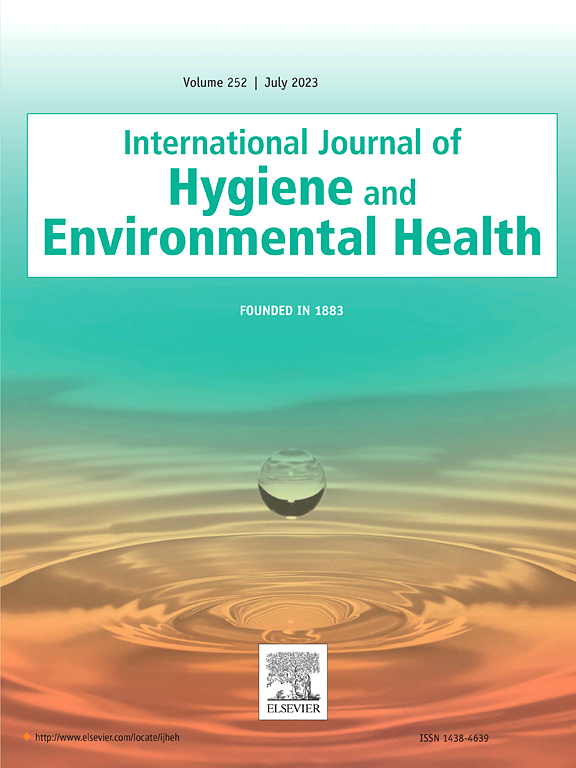学龄前儿童妊娠期接触邻苯二甲酸盐和行为问题,增加了自闭症谱系障碍的可能性。
IF 4.5
2区 医学
Q1 INFECTIOUS DISEASES
International journal of hygiene and environmental health
Pub Date : 2024-11-05
DOI:10.1016/j.ijheh.2024.114483
引用次数: 0
摘要
背景:实验研究表明,妊娠期接触邻苯二甲酸盐与后代的行为问题有关;然而,流行病学证据仍然参差不齐。本研究旨在调查妊娠期邻苯二甲酸盐暴露是否与学龄前儿童的行为问题有关:参与者包括来自 MARBLES(婴儿自闭症风险标记--学习早期迹象)的 178 对母子,这是一个自闭症谱系障碍(ASD)家族可能性较高的队列。我们对孕期第二和第三季度采集的多个母体尿液样本中的 14 种邻苯二甲酸酯代谢物进行了定量分析。学龄前行为问题使用儿童行为检查表(CBCL)进行评估,这是一种评估 1.5-5 岁儿童行为问题的标准化工具。为了研究 CBCL 分数与单个邻苯二甲酸酯生物标记物浓度及其混合物之间的关系,我们采用了负二项回归和加权量子和回归方法:总体而言,母体邻苯二甲酸盐生物标志物浓度与儿童行为问题无关。邻苯二甲酸单异丁酯(MiBP)浓度与儿童焦虑/抑郁症状和躯体不适呈反比关系。邻苯二甲酸单羟异丁酯(MHiBP)和邻苯二甲酸单苄酯(MBzP)也与躯体不适呈反比关系。在评估三个妊娠期的相关性时,更多的行为问题与第二个妊娠期的生物标记物浓度有关:邻苯二甲酸单(3-羧丙基)酯(MCPP)和邻苯二甲酸单羧异壬酯(MCNP)与躯体不适呈正相关。经过误发现率校正后,所有相关性都变得不显著。没有发现邻苯二甲酸盐混合物与 CBCL 评分之间存在关联:我们的研究没有发现妊娠期接触邻苯二甲酸盐会对儿童行为问题产生影响的明确证据。然而,我们基于对每位受试者多个样本进行生物监测评估得出的结果,可以提高我们对妊娠期邻苯二甲酸盐暴露与学龄前儿童行为问题相关性的认识。本文章由计算机程序翻译,如有差异,请以英文原文为准。
Gestational phthalate exposure and behavioral problems in preschool-aged children with increased likelihood of autism spectrum disorder
Background
Experimental studies have shown associations between gestational phthalate exposure and behavioral problems among offspring; however, epidemiological evidence is still mixed. This study aims to investigate whether gestational phthalate exposure is associated with behavioral problems in preschool-aged children.
Methods
Participants include 178 mother-child pairs from MARBLES (Markers of Autism Risk in Babies – Learning Early Signs), a cohort with high familial likelihood of autism spectrum disorder (ASD). We quantified 14 phthalate metabolites in multiple maternal urine samples collected during the 2nd and 3rd trimesters. Preschool behavior problems were assessed using the Child Behavioral Checklist (CBCL), a standardized instrument for evaluating behavior problems of children aged 1.5–5 years. To examine associations of CBCL scores with both individual phthalate biomarker concentrations and their mixture, we used negative binomial regression and weighted quantile sum regression.
Results
Overall, maternal phthalate biomarker concentrations were not associated with child behavior problems. Monoisobutyl phthalate (MiBP) concentrations were inversely associated with child anxious/depressed symptoms and somatic complaints. Mono-hydroxy-isobutyl phthalate (MHiBP) and monobenzyl phthalate (MBzP) were also inversely associated with somatic complaints. When assessing trimester-specific associations, more behavior problems were associated with the 2nd trimester biomarker concentrations: mono(3-carboxypropyl) phthalate (MCPP) and monocarboxyisononyl phthalate (MCNP) were positively associated with somatic complaints. All associations became non-significant after false discovery rate correction. No association between a mixture of phthalates and CBCL scores was found.
Conclusions
Our study observed no clear evidence of gestational phthalate exposure on child behavior problems. However, our findings based on the biomonitoring assessment of multiple samples per participant could improve our understanding of gestational phthalate exposure in association with behavior problems in preschool-aged children.
求助全文
通过发布文献求助,成功后即可免费获取论文全文。
去求助
来源期刊
CiteScore
11.50
自引率
5.00%
发文量
151
审稿时长
22 days
期刊介绍:
The International Journal of Hygiene and Environmental Health serves as a multidisciplinary forum for original reports on exposure assessment and the reactions to and consequences of human exposure to the biological, chemical, and physical environment. Research reports, short communications, reviews, scientific comments, technical notes, and editorials will be peer-reviewed before acceptance for publication. Priority will be given to articles on epidemiological aspects of environmental toxicology, health risk assessments, susceptible (sub) populations, sanitation and clean water, human biomonitoring, environmental medicine, and public health aspects of exposure-related outcomes.

 求助内容:
求助内容: 应助结果提醒方式:
应助结果提醒方式:


